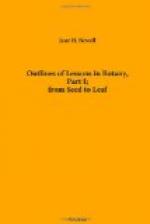From these experiments the pupils have seen that the life-sustaining quality of the air is used up by combustion and respiration. To bring in the subject of purification by plants, ask them why all the oxygen in the world is not exhausted by the people and the fires in it. After the subject has been explained, the following experiment can be prepared and put aside till the next lesson.
(4) Fill two bottles with air from the lungs, as in (3) having previously introduced a cutting from a plant into one of the bottles. Allow them to stand in the sun for a day or two. Then test both bottles with a burning match. If properly done, the result will be very striking. The end of the cutting should be in the water of the dish. This experiment will not succeed excepting with bottles such as are used for chemicals, which have their mouths carefully ground. Common bottles allow the air to enter between the bottle and the glass.[1]
[Footnote 1: See note on page 13.]
[Illustration: FIG. 3.]
4. Fuel.—Light a match and allow it to burn until half charred. Blow it out gently, so as to leave a glowing spark. When this spark goes out it will leave behind a light, gray ash. We have to consider the flame, the charred substance, and the ash.
Flame is burning gas. In all ordinary fuels, carbon and hydrogen, in various combinations and free, make the principal part. The first effect of the heat is to set free the volatile compounds of carbon and hydrogen. The hydrogen then begins to unite with the oxygen of the air, forming water, setting free the carbon, which also unites with oxygen, forming carbonic acid gas. The burning gases cause the flame. The following experiment will illustrate this.
[Illustration: Fig. 4.]
(5) Fit a test-tube with a tight cork, through which a bit of glass tubing, drawn out into a jet, is passed, the tubing within being even with the cork. Place some bits of shaving in the tube, cork it, and make the cork perfectly air-tight by coating it with bees wax or paraffine. Heat the test-tube gently over an alcohol lamp. The wood turns black, and vapor issues from the jet, which may be lighted (Fig. 4). Care should be taken to expel all the air before lighting.
(6) That the burning hydrogen forms water by uniting with the oxygen of the air, may be shown by holding a cold glass tumbler over the jet, or over any flame. The glass will be dimmed by drops of moisture.




